Food Procurement - Fishing Devices
You can make your own fishhooks, nets and traps and use several methods to obtain fish in a survival situation.
Improvised Fishhooks
You can make field-expedient fishhooks from pins, needles, wire, small nails, or any piece of metal. You can also use wood, bone, coconut shell, thorns, flint, seashell, or tortoise shell. You can also make fishhooks from any combination of these items (Figure 8-17).
To make a wooden hook, cut a piece of hardwood about 2.5 centimeters long and about 6 millimeters in diameter to form the shank. Cut a notch in one end in which to place the point. Place the point (piece of bone, wire, nail) in the notch. Hold the point in the notch and tie securely so that it does not move out of position. This is a fairly large hook. To make smaller hooks, use smaller material.
A gorge is a small shaft of wood, bone, metal, or other material. It is sharp on both ends and notched in the middle where you tie cordage. Bait the gorge by placing a piece of bait on it lengthwise. When the fish swallows the bait, it also swallows the gorge.
Stakeout
A stakeout is a fishing device you can use in a hostile environment (Figure 8-18). To construct a stakeout, drive two supple saplings into the bottom of the lake, pond, or stream with their tops just below the water surface. Tie a cord between them and slightly below the surface. Tie two short cords with hooks or gorges to this cord, ensuring that they cannot wrap around the poles or each other. They should also not slip along the long cord. Bait the hooks or gorges.-
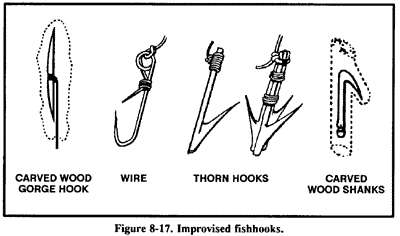
Gill Net
If a gill net is not available, you can make one using parachute suspension line or similar material (Figure 8-19).
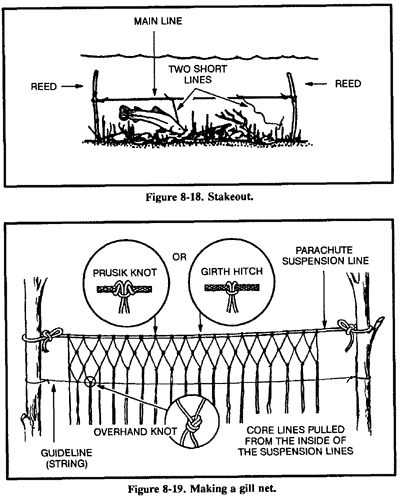
Remove the core lines from the suspension line and tie the easing between two trees. Attach several core lines to the easing by doubling them over and tying them with prusik knots or girth hitches. The length of the desired net and the size of the mesh determine the number of core lines used and the space between them. Starting at one end of the easing, tie the second and the third core lines together using an overhand knot. Then tie the fourth
and fifth, sixth and seventh, and so on, until you reach the last core line.
You should now have all core lines tied in pairs with a single core line hanging at each end. Start the second row with the first core line, tie it
to the second, the third to the fourth, and so on.
To keep the rows even and to regulate the size of the mesh, tie a guideline
to the trees. Position the guideline on the opposite side of the net you are working on. Move the guideline down after completing each row. The lines will always hang in pairs and you always tie a cord from one pair to a cord from an adjoining pair. Continue tying rows until the net is the desired width. Thread a suspension line easing along the bottom of the net to strengthen it. Use the gill net as shown in Figure 8-20.
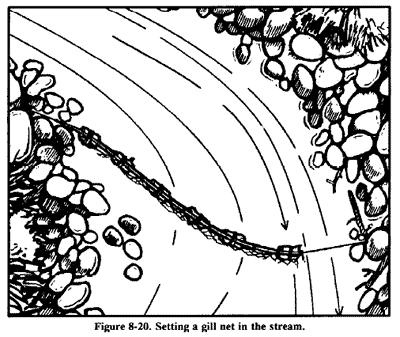
Fish Traps
You may trap fish using several methods (Figure 8-21). Fish baskets are one method. You construct them by lashing several sticks together with vines into a funnel shape. You close the top, leaving a hole large enough for the fish to swim through. You can also use traps to catch saltwater fish, as schools regularly approach the shore with the incoming tide and often move parallel to the shore. Pick a location at high tide and build the trap at low tide. On rocky shores, use natural rock pools. On coral islands, use natural pools on the surface of reefs by blocking the openings as the tide recedes. On sandy shores, use sandbars and the ditches they enclose. Build the trap as a low stone wall extending outward into the water and forming an
angle with the shore.
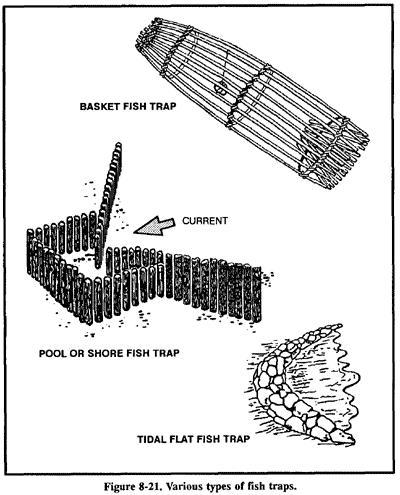
Spearfishing
If you are near shallow water (about waist deep) where the fish are large
and plentiful, you can spear them. To make a spear, cut a long, straight
sapling (Figure 8-22). Sharpen the end to a point or attach a knife, jagged piece of bone, or sharpened metal. You can also make a spear by splitting the shaft a few inches down from the end and inserting a piece of wood to act as a spreader. You then sharpen the two separated halves to points. To spear fish, find an area where fish either gather or where there is a fish run. Place the spear point into the water and slowly move it toward the fish. Then, with a sudden push, impale the fish on the stream bottom. Do not try to lift the fish with the spear, as it with probably slip off and you will lose it; hold the spear with one hand and grab and hold the fish with the other. Do not throw the spear, especially if the point is a knife. You cannot afford to lose a knife in a survival situation. Be alert to the problems caused by light refraction when looking at objects in the water.
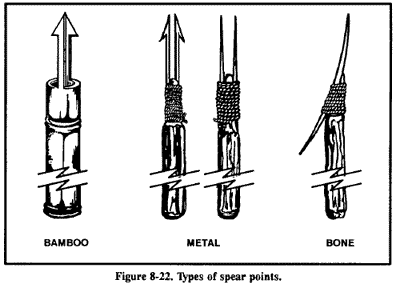
Chop Fishing
At night, in an area with a good fish density, you can use a light to attract fish. Then, armed with a machete or similar weapon, you can gather fish using the back side of the blade to strike them. Do not use the sharp side as you will cut them in two pieces and end up losing some of the fish.
Fish Poison
Another way to catch fish is by using poison. Poison works quickly. It allows you to remain concealed while it takes effect. It also enables you to catch several fish at one time. When using fish poison, be sure to gather all of the affected fish, because many dead fish floating downstream could arouse suspicion. Some plants that grow in warm regions of the world contain rotenone, a substance that stuns or kills cold-blooded animals but does not harm persons who eat the animals. The best place to use rotenone, or rotenone-producing plants, is in ponds or the headwaiters of small streams containing fish. Rotenone works quickly on fish
in water 21 degrees C (70 degrees F) or above. The fish rise helplessly to the surface. It works slowly in water 10 to 21 degrees C (50 to 70 degrees F) and is ineffective in water below 10 degrees C (50 degrees F). The following plants, used as indicated, will stun or kill fish:
- Anamirta cocculus (Figure 8-23). This woody vine grows in southern Asia and on islands of the South Pacific. Crush the bean-shaped seeds and throw them in the water.
- Croton tiglium (Figure 8-23). This shrub or small tree grows in waste areas on islands of the South Pacific. It bears seeds in three angled capsules. Crush the seeds and throw them into the water.
- Barringtonia (Figure 8-23). These large trees grow near the sea in Malaya and parts of Polynesia. They bear a fleshy one-seeded fruit. Crush the seeds and bark and throw into the water.
- Derris eliptica (Figure 8-23). This large genus of tropical shrubs and woody vines is the main source of commercially produced rotenone. Grind the roots into a powder and mix with water. Throw a large quantity of the mixture into the water.
- Duboisia (Figure 8-23). This shrub grows in Australia and bears white
clusters of flowers and berrylike fruit. Crush the plants and throw them into the water.
- Tephrosia (Figure 8-23). This species of small shrubs, which bears beanlike pods, grows throughout the tropics. Crush or bruise bundles of leaves and stems and throw them into the water.
- Lime. You can get lime from commercial sources and in agricultural
areas that use large quantities of it. You may produce your own by burning coral or seashells. Throw the lime into the water.
- Nut husks. Crush green husks from butternuts or black walnuts. Throw the husks into the water.
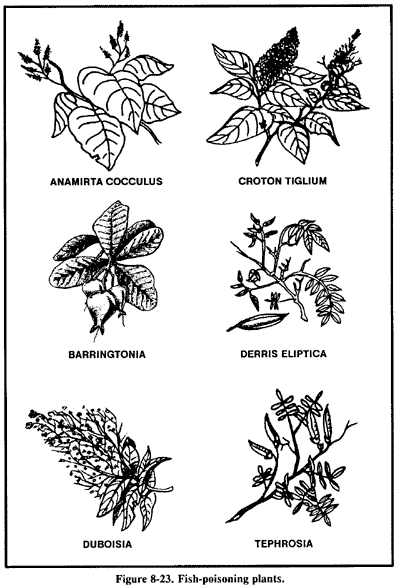

Survival Skills
Survival Actions
Psyhology of Survival
Survival Planning and Survival Kits
Survival Medicine
Survival Medicine - Requirements for Maintenance of Health
Survival Medicine - Medical Emergencies
Survival Medicine - Lifesavings Steps
Survival Medicine - Bone And Joint Injury
Survival Medicine - Bites and Stings
Survival Medicine - Wounds
Survival Medicine - Environmental Injuries
Survival Medicine - Herbal Medicines
Shelters
Shelters - Shelter Site Selection
Shelters - Types of Shelters
Water Procurement - Water Sources
Water Procurement - Still Construction
Water Procurement - Water Purification
Firecraft - Basic Fire Principles
Firecraft - Site Selection and Preparation
Firecraft - Fire Material Selection
Firecraft - How to Build a Fire
Firecraft - How to Light a Fire
Food Procurement - Animals for Food
Food Procurement - Traps and Snares
Food Procurement - Killing Devices
Food Procurement - Fishing Devices
Food Procurement - Preparation of Fish and Game for Cooking and Storage
Survival Use of Plants - Edibility of Plants
Survival Use of Plants - Plants for Medicine
Poisonous Plants
Dangerous Animals - Insects and Arachnids
Dangerous Animals - Poisonous Snakes
Dangerous Animals - Dangerous Lizards
Dangerous Animals - Saltwater Dangers
Field-expedient Weapons, Tools, and Equipment
Field-expedient Weapons - Lashing and Cordage
Field-expedient Weapons - Rucksack Construction
Field-expedient Weapons - Clothing and Insulation
Field-expedient Weapons - Cooking and Eating
Desert Survival - Terrain
Desert Survival - Environmental Factors
Desert Survival - Need For Water
Desert Survival - Heat Casualties
Desert Survival - Precautions and Desert Hazards
Tropical Survival - Tropical Weather
Tropical Survival - Jungle Types
Tropical Survival - Travel Through Jungle Areas
Tropical Survival - Immediate Considerations
Tropical Survival - Water Procurement
Tropical Survival - Food
Cold Weather Survival - Cold Regions And Locations
Cold Weather Survival - Basic Principles Of Cold Weather Survival
Cold Weather Survival - Hygiene and Medical Aspects
Cold Weather Survival - Cold Injuries
Cold Weather Survival - Shelters
Cold Weather Survival - Fire
Cold Weather Survival - Water
Cold Weather Survival - Food
Cold Weather Survival - Travel
Cold Weather Survival - Weather Signs
Sea Survival - The Open Sea
Sea Survival - Seashores
Expedient Water Crossings - Rivers and Streams
Expedient Water Crossings - Rapids
Expedient Water Crossings - Rafts
Expedient Water Crossings - Flotation Devices
Expedient Water Crossings - Other Water Obstacles
Field-expedient Direction Finding - Using the Sun and Shadows
Field-expedient Direction Finding - Using the Moon and the Stars
Field-expedient Direction Finding - Making Improvised Compasses
Field-expedient Direction Finding - Other Means of Determining Direction
Signaling Techniques
Signaling Techniques - Means For Signaling
Signaling Techniques - Codes and Signals
Signaling Techniques - Aircraft Vectoring Procedures
Survival Movement in Hostile Areas - Phases of Planning
Survival Movement in Hostile Areas - Execution
Survival Movement in Hostile Areas - Return to Friendly Control
Camouflage - Personal Camouflage
Camouflage - Methods Of Stalking
Contact With People
Contact With People - The Survivorís Behavior
Survival In Man-made Hazards - The Nuclear Environment
Survival In Man-made Hazards - Biological Environments
Survival In Man-made Hazards - Chemical Environments
Survival Actions
Psyhology of Survival
Survival Planning and Survival Kits
Survival Medicine
Survival Medicine - Requirements for Maintenance of Health
Survival Medicine - Medical Emergencies
Survival Medicine - Lifesavings Steps
Survival Medicine - Bone And Joint Injury
Survival Medicine - Bites and Stings
Survival Medicine - Wounds
Survival Medicine - Environmental Injuries
Survival Medicine - Herbal Medicines
Shelters
Shelters - Shelter Site Selection
Shelters - Types of Shelters
Water Procurement - Water Sources
Water Procurement - Still Construction
Water Procurement - Water Purification
Firecraft - Basic Fire Principles
Firecraft - Site Selection and Preparation
Firecraft - Fire Material Selection
Firecraft - How to Build a Fire
Firecraft - How to Light a Fire
Food Procurement - Animals for Food
Food Procurement - Traps and Snares
Food Procurement - Killing Devices
Food Procurement - Fishing Devices
Food Procurement - Preparation of Fish and Game for Cooking and Storage
Survival Use of Plants - Edibility of Plants
Survival Use of Plants - Plants for Medicine
Poisonous Plants
Dangerous Animals - Insects and Arachnids
Dangerous Animals - Poisonous Snakes
Dangerous Animals - Dangerous Lizards
Dangerous Animals - Saltwater Dangers
Field-expedient Weapons, Tools, and Equipment
Field-expedient Weapons - Lashing and Cordage
Field-expedient Weapons - Rucksack Construction
Field-expedient Weapons - Clothing and Insulation
Field-expedient Weapons - Cooking and Eating
Desert Survival - Terrain
Desert Survival - Environmental Factors
Desert Survival - Need For Water
Desert Survival - Heat Casualties
Desert Survival - Precautions and Desert Hazards
Tropical Survival - Tropical Weather
Tropical Survival - Jungle Types
Tropical Survival - Travel Through Jungle Areas
Tropical Survival - Immediate Considerations
Tropical Survival - Water Procurement
Tropical Survival - Food
Cold Weather Survival - Cold Regions And Locations
Cold Weather Survival - Basic Principles Of Cold Weather Survival
Cold Weather Survival - Hygiene and Medical Aspects
Cold Weather Survival - Cold Injuries
Cold Weather Survival - Shelters
Cold Weather Survival - Fire
Cold Weather Survival - Water
Cold Weather Survival - Food
Cold Weather Survival - Travel
Cold Weather Survival - Weather Signs
Sea Survival - The Open Sea
Sea Survival - Seashores
Expedient Water Crossings - Rivers and Streams
Expedient Water Crossings - Rapids
Expedient Water Crossings - Rafts
Expedient Water Crossings - Flotation Devices
Expedient Water Crossings - Other Water Obstacles
Field-expedient Direction Finding - Using the Sun and Shadows
Field-expedient Direction Finding - Using the Moon and the Stars
Field-expedient Direction Finding - Making Improvised Compasses
Field-expedient Direction Finding - Other Means of Determining Direction
Signaling Techniques
Signaling Techniques - Means For Signaling
Signaling Techniques - Codes and Signals
Signaling Techniques - Aircraft Vectoring Procedures
Survival Movement in Hostile Areas - Phases of Planning
Survival Movement in Hostile Areas - Execution
Survival Movement in Hostile Areas - Return to Friendly Control
Camouflage - Personal Camouflage
Camouflage - Methods Of Stalking
Contact With People
Contact With People - The Survivorís Behavior
Survival In Man-made Hazards - The Nuclear Environment
Survival In Man-made Hazards - Biological Environments
Survival In Man-made Hazards - Chemical Environments